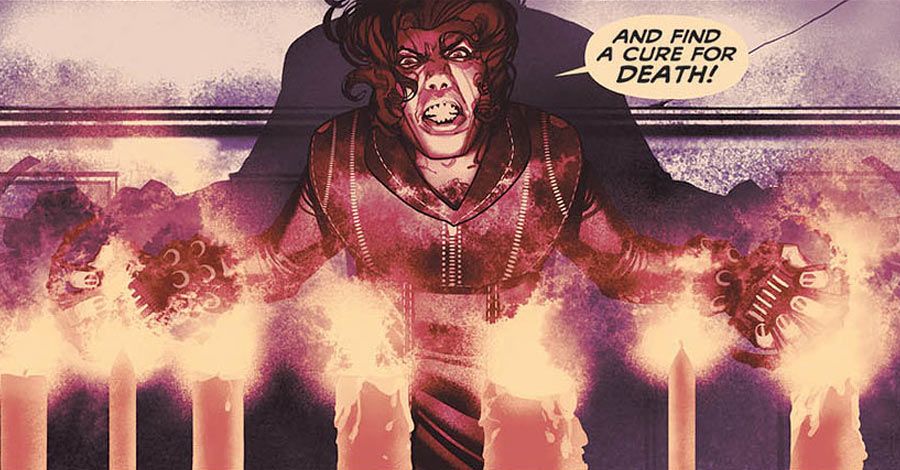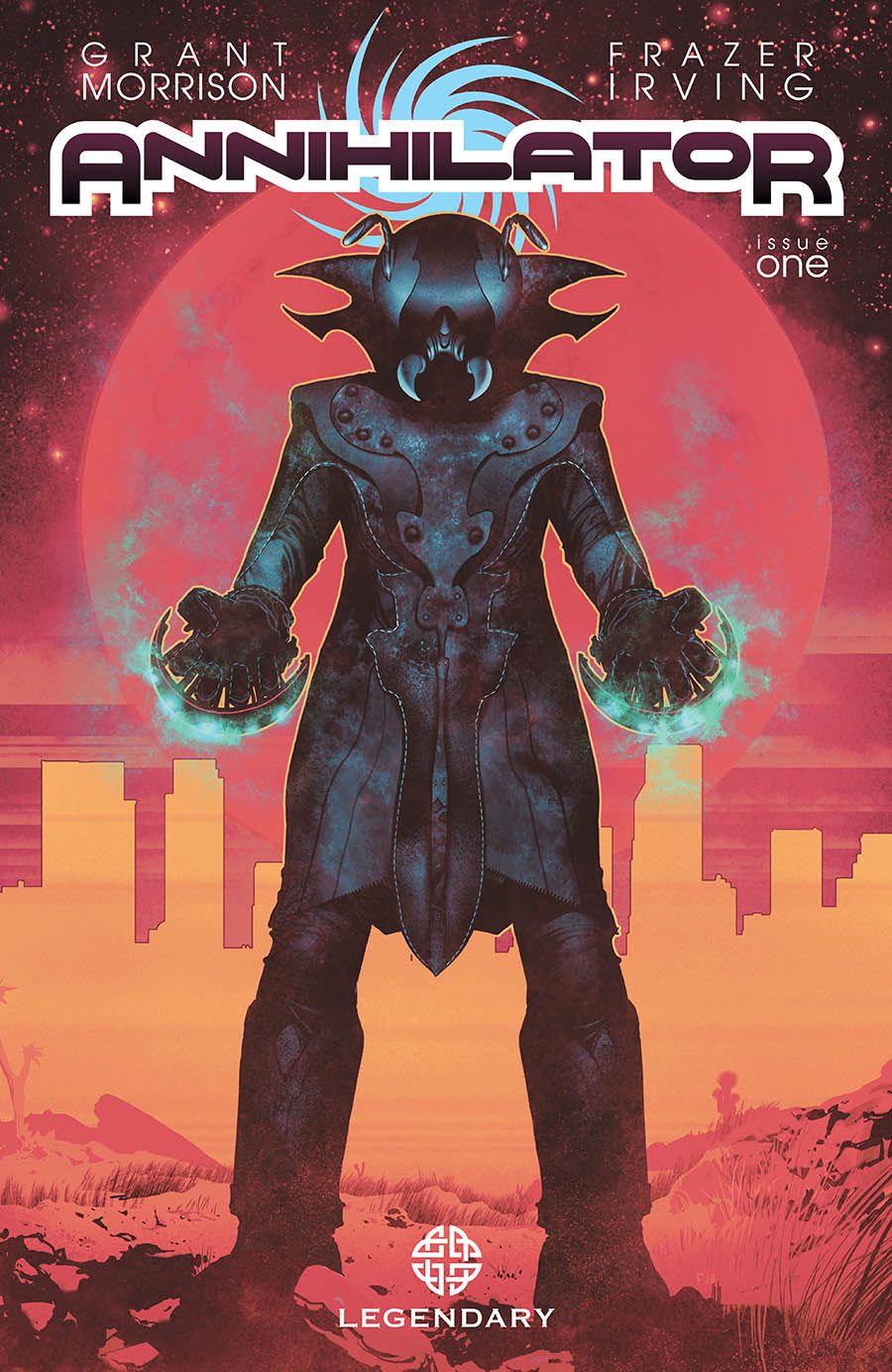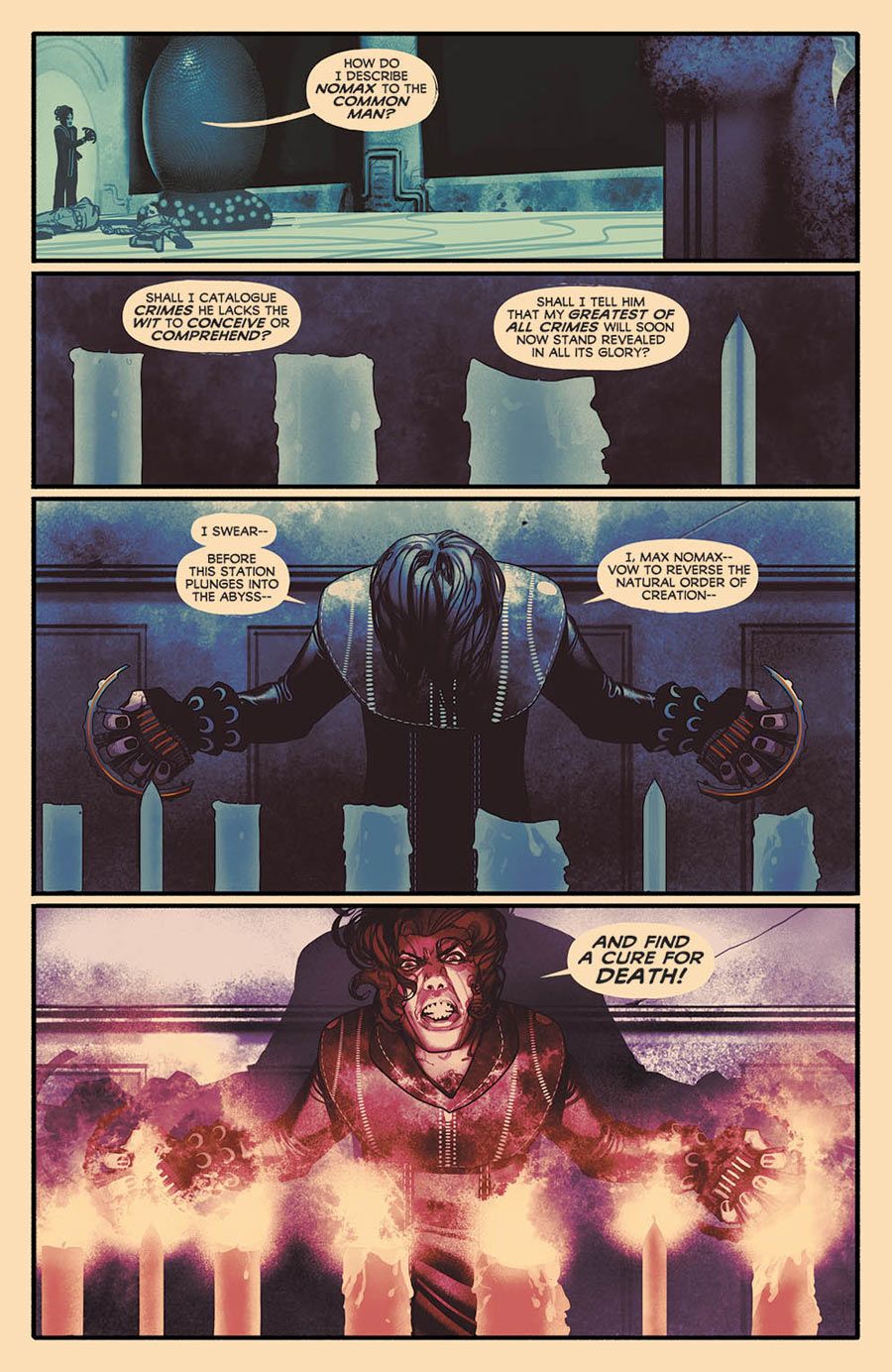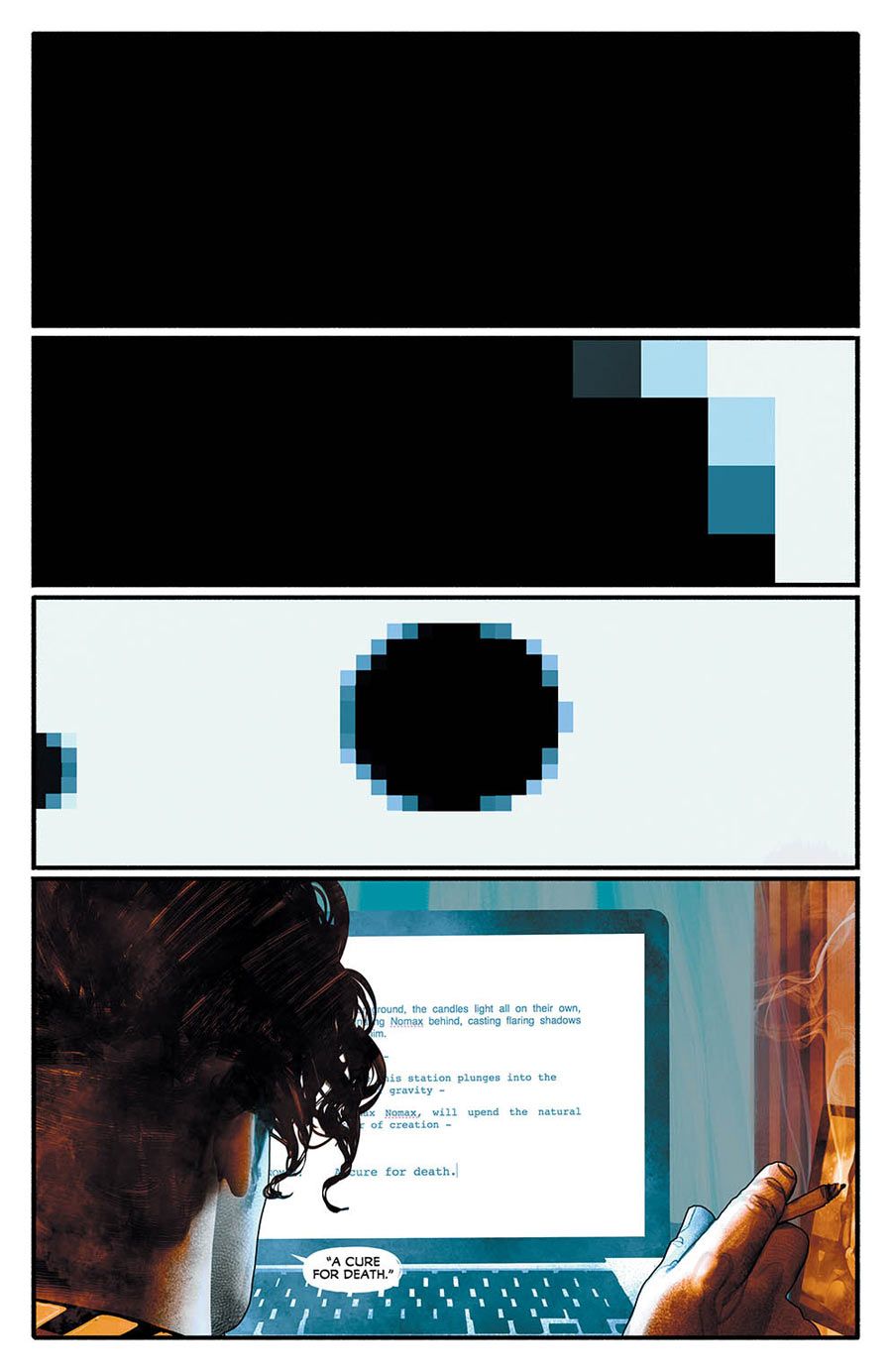It's a big year for Grant Morrison projects. Not only is his long-awaited "The Multiversity" currently releasing from DC Comics, Legendary Entertainment is set to debut "Annihilator" on September 3. Announced in 2012, the six issue miniseries by Morrison and artist Frazer Irving centers on Ray Spass (pronounced "Space"), a washed-up screenwriter who has one final shot at glory: a film centering around science fiction character Max Nomax -- but as it turns out, Nomax is actually real, and Spass is writing his biography. Now, the washed-up screenwriter has seven days before he dies to finish Nomax's story.
RELATED: Grant Morrison Says "The Multiversity" is a "Culmination" of His DC Comics Work
CBR News discussed the concept and development of "Annihilator" with Morrison, who revealed details about the story and its characters, including how the series plays with the structure of a typical Hollywood film, why it serves as a commentary piece about his time in Los Angeles, the pulp hero origins of Max Nomax, the perfect fit of Frazer Irving's art and more.
CBR News: Grant, "Annihilator" was announced in 2012, and it's been a long road to get to release. You said once in an interview that the entire concept came from a challenge by Rian Hughes to do something that was as intricate as "Watchmen."
Grant Morrison: [Laughs] Oh, wow! I'd actually forgotten that challenge, but yes, you're right!
Well, how do you think you've succeeded in that challenge so far?
I think I completely forgot the original challenge, and created something on its own merits, honestly. It's its own thing. It revolves around a central conceit of the idea that the center of our galaxy is a black hole called The Great Annihilator by astronomers that seems to be causing the movement of entire constellations and stellar material. I [wanted] to get into the idea, the notion that all art and all of our endeavors are basically built around a black abyss. When we circle that thing and we describe what we see when we fall into the black hole -- that's what this became about. So, that was the central motif; the swallowing hole.
Ray Spass is somewhat unlike other characters you've created in the past, in that he's a completely normal screenwriter in Hollywood with no powers. What was the draw for you in approaching such a high-concept story through the lens of a seemingly normal person like Ray as the focal point?
I basically wanted to write about Hollywood, and Hollywood is all about the illusion -- and the illusion is ultimately created by screenwriters and directors and writers in the first place. But it's all about writing stories and making up stories. I wanted to write about my Hollywood experience and the fact that I've written a bunch of studio screenplays that have never been made, and I've met a bunch of people who are very strange and fit into that Hollywood ecology. [I wanted to write] something that people could read and make sense of and summed up how I feel about Los Angeles.
How much of yourself is in Ray, and how much of it draws from some of the other people you've met there?
Not so much [drawn from me]. What I've been telling people is that usually I put a lot of myself in characters -- it's all about me, it's all about my feelings. But with Ray, Ray is someone that I've actually observed and friends I've had and people I've worked with and have been in Hollywood for a long time. So, for the first time, I think I've created a character that's not necessarily narcissistic. [Laughs] Ray is about other people and not about me.
The first issue lays a lot of groundwork for readers to wrap their heads around, and it seems like the story has a lot of depth that goes beyond the initial reading, much like your other work. It actually takes a couple of reads to really access everything the book does.
Yeah, but I think comic books are so expensive that they should be worth at least a few reads, you know?
Tell us a bit about the long game you have planned. It feels, at least from the first issue, that "Annihilator" really plays that long game in terms of story.
Yeah, it's all about the notion of being on deadline, actually. For Ray, it becomes concrete. If he doesn't write the screenplay in seven days, he actually dies. It's kind of playing with that idea and the idea of people's expectations. Nomax has no memory, so he can't remember who he was. So he has to wait for Ray to unveil this through the screenplay. It's all about the Hollywood thing of artifice underneath these seething, satanic, diabolic energies.
The deadline concept is really quite clever -- have you ever felt like that yourself, where if you don't make deadline by a certain point, you're going to die?
Yeah! Of course I have -- for years when I was always behind on deadlines. I was always two or three days behind, and it just felt like torture. It was horrible. Doing the same work when you're ahead of deadline is very different than when you're doing the same work when you're behind deadline. I'm sure you know it -- I think we all know it. It's a terrible feeling. When you're behind the eight ball, then it's a really bad feeling.
Going back to the first issue and all the groundwork laid, how much will concepts and teases introduced in the first issue apply across the course of the series?
Well, it changes. I wanted to do a really good Hollywood story as well, where halfway through, we get the game-changing moment, but then act three begins. It's very much in the spirit of those "How to Write Hollywood Screenplays" books. So, again, the whole piece is quite heavily structured.
Nomax seems to be a throwback to pulp characters of old science fiction stories -- though in this case, he's actually real. What was the appeal for you in drawing from those old pulp fiction stories for that side of "Annihilator"?
Me and Frazer have done the Batman stuff, as you know, so I wanted to see Frazer taking this out to the limit. We started with things like the early, the surrealist kind of character. We were looking at "Danger Diabolik" and "Criminale" -- all these weird 1970s comic strips that were ultimately banned because they were so sexual and violent, but they all featured the same kind of antihero. We wanted to get right to the root of that character that's haunted human imagination for so long. The Hamlet, the Faust -- all the characters that dress in black and have high cheekbones. [Laughs] We wanted to make Nomax the epitome of that character and is actually the real thing that inspired all the portrayals.
I'm glad you mentioned Frazer, because his art in that first issue is just fantastic.
It's astonishing! The guy paints in light. It's beautiful.
What was it about Frazer's art that you feel lent itself well to the large, vast story you had to tell?
Well, I wrote it for him. He came first and I thought, "What would be the best thing for Frazier to draw?" and I created this story for him. The way he captured that perfect antihero, the big dark man who's kind of outside of society, but fights for something -- it was all about that. I wanted to get right to the root of it and the archetype of it. I felt Frazer was the most contemporary artist to capture that vibe, especially after Batman. I think he's proved it. His work is astonishing on this, he's really ahead of the pack.
What's been the biggest challenge for you when it comes to crafting "Annihilator"? How does putting a story like that together differ from something like "The Multiversity"?
Well, "Multiversity" is dealing with an already existing universe, and it has its rules. As I say, superhero characters aren't real, but they have rules. But with "Annihilator," we wanted to actually talk about real life, and specifically Hollywood and the movies and the illusion. America has always presented itself through an illusion. Even the way that women are treated in Hollywood, the archetype of the girl who is always under threat to be protected by the male. We wanted to use those stories to talk about all that stuff that's fundamental to western culture.
Could you expand on that a bit? What else do you hope to accomplish with "The Multiversity?
Something like "Multiversity," is all about parallel universes, so each book is a very different style of storytelling, a very different way of looking at the world. It's ultimately -- I'm just trying to remind people that there's a dozen personalities inside itself. There's a cruel judge, there's a comedian, there's a lover. We all see the world every day as different. This new work is all about reminding people how we see the world through different eyes and the archetypes and the personas that we all contain inside ourselves. So, it's a public service, really. [Laughs]
Transitioning back to "Annihilator," I was struck by how much the art and prose played with the dichotomy between light and dark -- the black hole, the daytime scenes of Hollywood. How much does that contrast play into the series moving forward?
It's all about that, but it's also about the fact that those things can't exist without each other. That's what Nomax and Ray are. That's what the light, the dark; the fiction, the real; the male, the female; the up, the down -- they can't exist without [one another]. We've got this weird tension with opposites -- in our world, it's all about up, down; left, right; female, male; good, evil -- yeah, it's about that and these two characters are different sides of our coin. Even the female -- the girl -- who appears in issue #3 starts to become more important. There's a different side to all that. I'm just trying to write myths about the world we live in, and using them to [discuss] what we're all into and what affects people and to talk about what it means to be alive.
You mentioned earlier that you normally put yourself into characters, but Ray is based more on people that you've met -- but what about Nomax?
Yeah, Nomax is a rebel, satanic asshole -- the kid from your old seventeen that you all thought was going to grow up to be a messiah. That's Nomax, and it's kind of blown up to archetypal proportions, but he definitely is like the 17-year-old self made manifest. [Laughs]
I hope people check it out. As I say, it's hard to interest people in stuff that isn't Marvel or DC, but I'm so into this book. I think Frazer's work is so good that people deserve to look at it. That's all I can say. It's a really, really good comic book.
"Annihilator," by Grant Morrison and Frazer Irving, arrives September 3.




